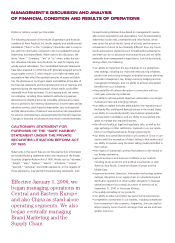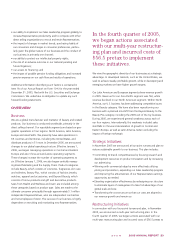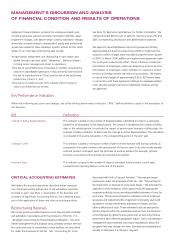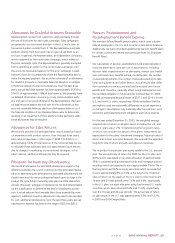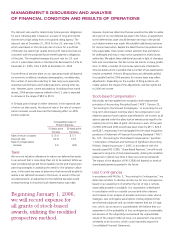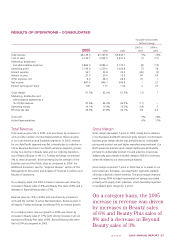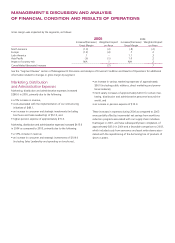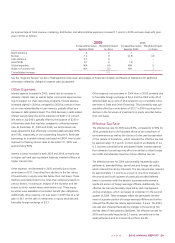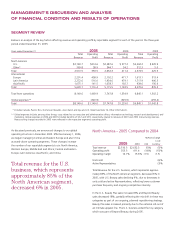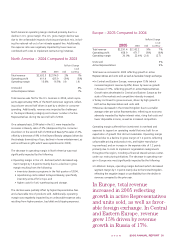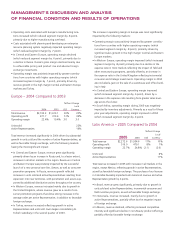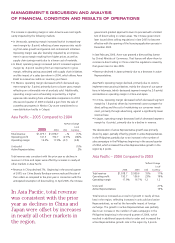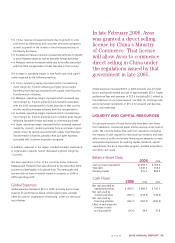Avon 2005 Annual Report Download - page 6
Download and view the complete annual report
Please find page 6 of the 2005 Avon annual report below. You can navigate through the pages in the report by either clicking on the pages listed below, or by using the keyword search tool below to find specific information within the annual report.
MANAGEMENT’SDISCUSSIONANDANALYSIS
OFFINANCIALCONDITIONANDRESULTSOFOPERATIONS
The discount rate used for determining future pension obligations
for each individual plan is based on a review of long-term bonds
that receive a high rating from a recognized rating agency. The
discount rate at December 31, 2005 for the U.S. plan was 5.5%,
which was based on the internal rate of return for a portfolio
of Moody’s Aa-rated high quality bonds with maturities that are
consistent with the projected future benefit payment obligations
of the plan. The weighted-average discount rate for U.S. and
non-U.S. plans determined on this basis has decreased to 5.2% at
December 31, 2005, from 5.65% at December 31, 2004.
Future effects of pension plans on our operating results will depend
on economic conditions, employee demographics, mortality rates,
the number of associates electing to take lump-sum payments,
investment performance and funding decisions, among other fac-
tors. However, given current assumptions (including those noted
above), 2006 pension expense related to the U.S. plan is expected
to increase in the range of $8.0 to $10.0.
A 50 basis point change (in either direction) in the expected rate
of return on plan assets, the discount rate or the rate of compen-
sation increases, would have had the following effect on 2005
pension expense:
Increase/(Decrease) in
Pension Expense
50 basis point 50 basis point
Increase Decrease
Rate of return on assets $ (5.1) $ 5.1
Discount rate (12.3) 12.9
Rate of compensation
increase 4.0 (3.8)
Taxes
We record a valuation allowance to reduce our deferred tax assets
to an amount that is more likely than not to be realized. While we
have considered projected future taxable income and ongoing tax
planning strategies in assessing the need for the valuation allow-
ance, in the event we were to determine that we would be able to
realize a net deferred tax asset in the future, in excess of the net
recorded amount, an adjustment to the deferred tax asset would
increase earnings in the period such determination was made.
Likewise, should we determine that we would not be able to realize
all or part of our net deferred tax asset in the future, an adjustment
to the deferred tax asset would decrease earnings in the period
such determination was made. We establish additional provisions
for income taxes when, despite the belief that our tax positions are
fully supportable, there remain certain positions that are likely to
be challenged and may or may not be sustained on review by tax
authorities. We adjust these additional accruals in light of changing
facts and circumstances. We file income tax returns in many jurisdic-
tions. In 2006, a number of income tax returns are scheduled to
close by statute and it is possible that a number of tax examinations
may be completed. If Avon’s filing positions are ultimately upheld,
it is possible that the 2006 provision for income taxes may reflect
adjustments. Depending on the number of filing positions ulti-
mately upheld, the impact of the adjustments could be significant
to 2006 net income.
Stock-based Compensation
Historically, we have applied the recognition and measurement
principles of Accounting Principles Board (“APB”) Opinion 25,
“Accounting for Stock Issued to Employees,” in accounting for our
long-term stock-based incentive plans. No compensation cost
related to grants of stock options was reflected in net income, as all
options granted under the plans had an exercise price equal to the
market price on the date of grant. Net income in each of the years
of 2005, 2004 and 2003 would have been lower by $31.1, $26.3
and $28.7, respectively, if we had applied the fair value recognition
provisions of Statement of Financial Accounting Standards (“FAS”)
No. 123, “Accounting for Stock-Based Compensation” (see Note
1, Description of Business and Summary of Significant Accounting
Policies). Beginning January 1, 2006, in accordance with the
recently issued FAS 123(R), “Share-Based Payment,” we will record
expense for all grants of stock-based awards, utilizing the modified
prospective method (see Note 2, New Accounting Standards).
The impact of the adoption of FAS 123(R) will depend on levels of
share-based payments granted in the future.
Loss Contingencies
In accordance with FAS No. 5, “Accounting for Contingencies,” we
determine whether to disclose and accrue for loss contingencies
based on an assessment of whether the risk of loss is remote,
reasonably possible or probable. Our assessment is developed
in consultation with our outside counsel and other advisors
and is based on an analysis of possible outcomes under various
strategies. Loss contingency assumptions involve judgments that
are inherently subjective and can involve matters that are in litiga-
tion, which, by its nature is unpredictable. We believe that our
assessment of the probability of loss contingencies is reasonable,
but because of the subjectivity involved and the unpredictable
nature of the subject matter at issue, our assessment may prove
ultimately to be incorrect, which could materially impact the
Consolidated Financial Statements.
Beginning January 1, 2006,
we will record expense for
all grants of stock-based
awards, utilizing the modified
prospective method.


